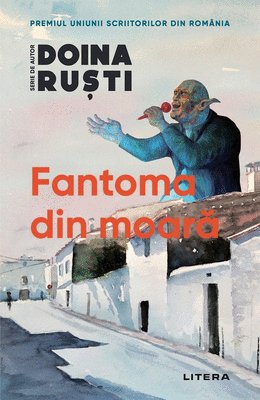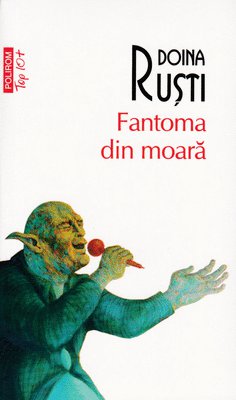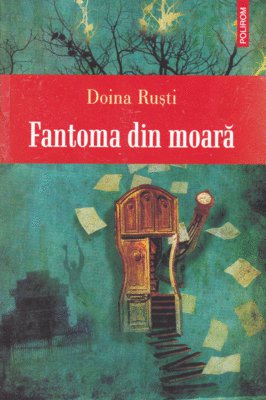




Doina Ruși's book presents a wide range of literary skills, which give the measure of resistance in the Romanian history of the 20th century.
Markus Bauer, Neue Zürcher Zeitung, 4 01, 2018
The product of a powerful original prose writer, a rara avis in post communist Romanian literature, The Ghost in the Mill is not only a first-rate literary event of the current year, but also one of the most convincingly poignant works of fiction addressing the topic of local communism to be published during the last decade.
Paul Cernat, Revista 22, Bucureștiul cultural
The Ghost in the Mill is an imaginative novel, in line with autobiographical fiction, in which magic realism and daily realism intertwine. [...] This mill, which is an axis mundi, the center, the hearth and the obsession of the village, where the character has no clue if he has met the angel or the devil, this mill is the place where a murder occurs, as at the dawn of all worlds: a certain Max, an epileptic, is killed by mistake [...] and everybody is obliged to keep silent, thus becoming accomplices in the murder. We have all been accomplices in what has defined and punished us. This is the parable of communism. A novel with substance, a sinewy prose which, I repeat, equals a part or several parts of Cărtărescu's Orbitor
Dan C. Mihăilescu, Omul care aduce cartea, ProTV
Romanian author Doina Ruști’s novel The Ghost in the Mill (2008), writer Manuel Rivas, The Crpenten’s Pencil (1998) in wich the ghost of an artist executed by Falangist militia haunts a pencil (and its future user).
Jeffry Andrew Weinstock, The Ashgate Encyclopedia of Literary Cinematic Monsters Routledge, New York, 2016
Doina Ruști has the vocation of a builder constructor, the capacity to build a meaningful narrative and exuberant imagination. If asked to recommend certain characters, pages or sequences from the second part of The Ghost in the Mill, I wouldn't know which to mention first, because almost all of them are remarkable. There is no doubt that it would be far too less if I only mentioned Săndina, the old cooperative worker, that lurks around the deserted mill and writes, without anybody suspecting her, informative notes for the Secret Police, the grotesque Gabriel Neicușoru, the unctuos physicist from the Phenomena Institute, or the terrifying scene where the mill is demolished."
Bianca Burța Cernat, Observator cultural
The characters drawn by Doina Rusti are incredibly genuine: the author has the rare gift of seeing things both in a synthetical and a contingent way, including detail within the portrait. The core of the novel is the second part: The Mill, being slightly over 200 pages and exceptional. It is this time-space condensed sequence that reveals the great qualities of the author; these are the narrative construction and the capacity to suggest the texture (substance) of a certain humanity.
Mihai Iovănel, Cultura, no.4, January 29, 2009
Doina Ruști is a mature, complete writer, one of the most professional Romanian writers today, with well-defined themes of work and a qualified view on the way literature should be written. Her talent does not necessarily stand for her ability to build phrases, but characters and situations which are not only convincing, but also give you the sentiment of contingency. The imagined scenes are stringent and their fall-like succession is overwhelming. The theme of communism suits very well with such a gifted writer, the demoniacal history of the terrible 45 years that Romania has undergone in the isolated space of a village.
Doris Mironescu, Suplimentul de cultură, May 9-15, 2009
p. 177
Doina Ruști joins the elite of our still youthful prose writers with her third novel, both ambitious and masterful. (...) The second part, the longest one (of The Ghost in the Mill) is read and assimilated with higher difficulty, as the description is a little too detailed, almost journalistic. But it is worth reading. The whole construction is remarkable: the epic matter, both dense and fluid, typologically diversified and symbolically rearticulated; the varying rhythm, alert or slow, of the narrative; the clever assemblage and great control. And above everything, an obvious artistic maturity.
Daniel Cristea Enache, Timpuri noi, Ed. Cartea Romanească, 2009,
The Ghost in the Mill is, from my point of view, the best novel published last year.
Șerban Axinte, Observator cultural, no. 459, January 29, 2009
The Ghost in the Mill is, without any doubt, one of the landmarks of Romanian contemporary prose, because of the technical clearness of the writing which simulates innocence, the morbid-exuberant imagination and, last but not least, the convincing manner in which it revisits the totalitarian period, with tender detachment, obsession for details and understanding.
Gabriel Coșoveanu, Ramuri, no. 10, October, Craiova, 2008
The protagonist [The Ghost in the mill ] is indeed a scepter, hidden in a ruined mill, a topos of horror, but an obsessive attraction for people of Comosteni-village. In several hundred pages, the novel exposes the story of a family and many individual micro-narrations. The characters are transformed in kafkian style under the influence of totalitarian system, so that the final section, entitled Two days, is a delta for all wild rivers of life with the flavor of burnt rubber.
Gabriel Coșoveanu, Ramuri, no. 10, October, Craiova, 2008
Writing The Ghost in the Mill in order to exorcise the haunting spectre of communist times, Doina Ruști marks an interesting break with the Romanian literary tradition. In tune with international trends, she follows the pattern of ghost stories to reactivate a dreadful past that would not be stifled or silenced. Through the intrusion of unexplainable spectres in the life of a rural community under dictatorial rule and through the central image of a threatening and luring old mill, Ruști manages to create a Gothic novel born out of a history of fear, secrets, betrayal, guilt and broken ties. In so doing, she moves beyond the magic realism to which many writers resorted in the late communist and early post-communist period in an attempt to escape the levelling pressure of socialist realism and the censorship that came along with it. Although her use of Gothic themes and motifs represents a deviation from both old and new Romanian literary norms, which have never really accommodated the genre, the negotiation of the collective past with the tools provided by the Gothic ultimately proved successful, bringing the author high critical acclaim and international recognition. Ruști capitalizes on the genre's interest in individual trauma and unrest, in the shattered autonomy of the individual, in the loss of coherence, wholeness and in fragmented consciousnesses, in failed relationships, oppression and suffocating anxiety. She deftly adapts the seemingly unlikely Gothic toolbox to Romanian social realities before December 1989, making the most of the genre's tried and tested disquieting, disruptive potential.
Raluca Andreescu,The Ghost of Communism Past The Birth of Post-Communist Gothic Fiction, Zittaw Press, 2011
In her novel Fantoma din moara, or The Ghost in the Mill, Doina Rusti has helped in the process of preserving history, specifically that of communist Romania. A village in the Romanian countryside, populated by people whose stories had been discounted, or never even told, acts as the perfect microcosm to isolate the Romanian identity while examining its multifaceted elements from disparate perspectives that all reify within the frame narrator. Rusti synchronously experiences both past and present, negating a traditional trajectory along a temporal axis. This is indicative of the act of remembering that is intricately tied to the mechanism of forgetting. Memories are brought into question and Rusti uses her novels to join the chorus of those solidifying the Romanian past, even if not always harmoniously. Rusti’s dependence on previously documented events that serve as parameters for her novel challenge the power that gives authority to authorship. She cannot freely create her narratives, but can only carefully navigate the restrictions of their respective situations. Defining a culture and its people is no small task, but as the book closes, Rusti unapologetically paints an unromanticized picture producing a sophisticated understanding of an entire nation as it turns to spirituality during very tumultuous times.
Christene d’Anca - Mediating a loss of history in Doina Rusti’s The Ghost in the Mill by Journal of European Studies, vol. 48, 3-4: pp. 265-277, October 22, 2018.
Doina Rusti’s book The Ghost at the Mill, a novel published in 2008 and recently translated in German, tells a story on the consequences of communism, in which the love for books went through fire in a literal way and was pierced by sword. This is a fragment from the book:
Ion Nicolescu slowly followed the guardians... but did not dare to tell them to let him have the books he loved, at least Eminescu’s leather-bound edition, or Memories from Childhood. How could this book be hostile? When they see the books from his bookcase, they will leave without destroying anything. Not to mention that he could not imagine how they would do that... (p. 416).
Carmen Gheorghe, The Book and the Separate Room, Trivent Publishing, 2018
Magical realism or marvellous realism is a genre of narrative fiction and, more broadly speaking, art that, while encompassing a range of subtly different concepts, expresses a primarily realistic view of the real world while also adding or revealing magical elements. Doina Rusti’s novels abound in such elements, taking the reader on a literary journey. This Romanian writer’s literary art fits into this magical realm through the playful function of writing, the poetry of life facets and the cult of spontaneity which impress through the carousel of post-modern narrative techniques. more
Pompilia Chifu
The passage functions as a metaphorical anticipation of Lucica’s rape at a Party feast and the consequent unwanted pregnancy. The little embryo “fermenting” inside her is felt as something alien and decaying, the concrete sign of tainting, and the woman’s body is only a container for guilt.
Unlike the victims, the agents of the Power are involved in amorous, erotic encounters with the Ghost. Grigore, the militiaman, could feel pulsating in his blood “the warm body of the ghost, which made him feel like a velvet cover inside which a precious jewel was sleeping carelessly”. Despite the obvious differences, despite their antagonistic emotions, both victims and oppressors have a common form of life: even for the privileged of the communist regime, the individual is just a hollow case whose only purpose is to find something else outside, to fill the void. After the mystical-erotic union with his ghost, Gabriel Neicușoru abruptly loses his memory, “and this sudden detachment was flowering together with his new and comfortable position, of being the shell of his beloved”. It is a “union” that falsifies both past and present events and cancels responsibility. Neicușoru, the one who had previously abused Lucica, is convinced, in the end, that “he was the only one untouched by the atrocities of a historical flow that had thrown up all over his fellows”.
It is significant that in The Ghost in the Mill, characters receive an important role in the narrative only after they become “something else”, after they are “transformed into rags by history”
...
In The Ghost in the Mill, in a game of multiplying narrative perspectives, the author introduces a belated spectator that steals the memory of the witness Adela Nicolescu, manipulates and falsifies it, commercially presenting it as a popular novel, The Secret Life of Adela Nicolescu. The protagonist sees herself as a character in somebody else’s story. This narrative formula could be interpreted as an attempt to illustrate the “exotic” past, the stolen life, the treacherous memory, the self-as-other, the morphing of a human person into a personage in a popular play that sees her past life represented without having been understood.
Elena Crașovan